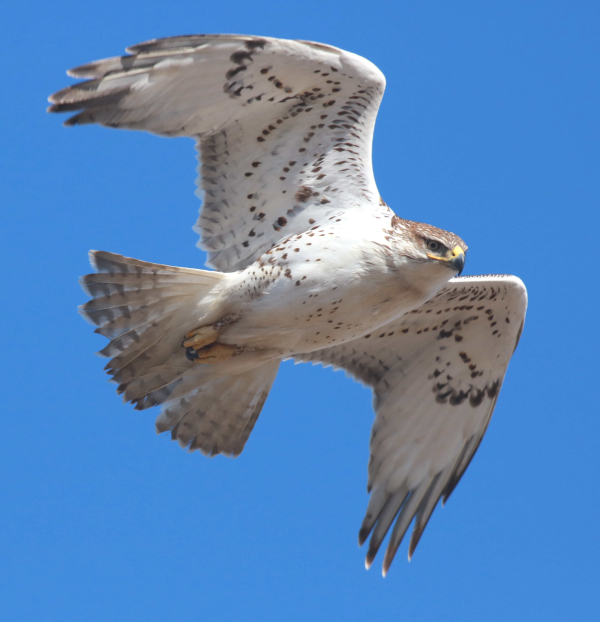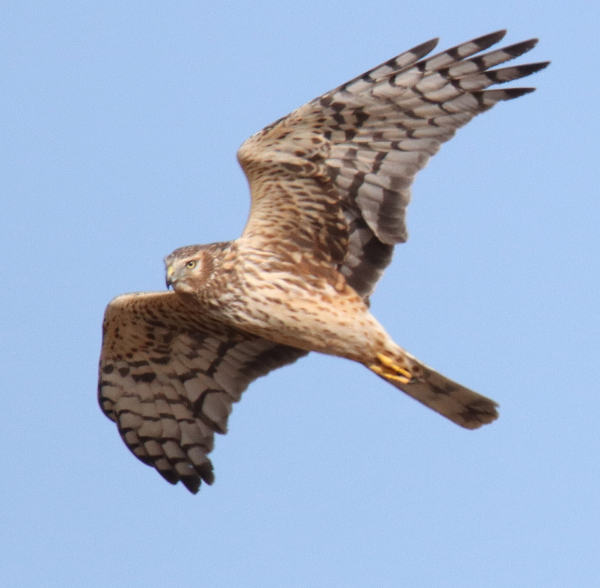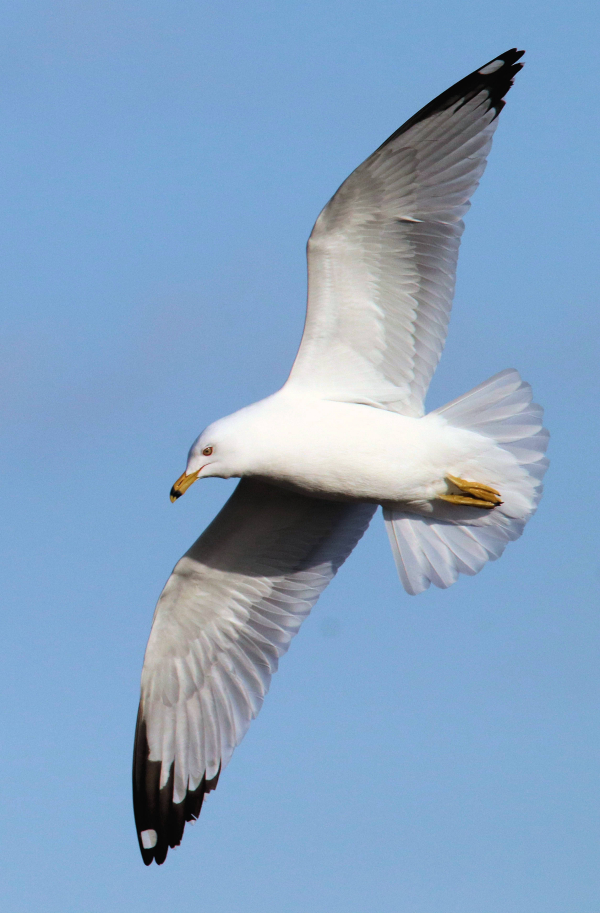
A surprise sighting of a yearling Ferruginous Hawk provided a jolt of excitement while birding just 6 miles south of the office Friday afternoon.

Waterfowl at the edge of the ice is the theme for this week’s Bird Photography feature and this photo of a drake Common Goldeneye, photographed just 3 miles south.

Only a mile south of the office, a female Northern Harrier was a momentary surprise as it hugged the stout north wind while I was trying to photograph a too-distant Bald Eagle.

Ring-billed Gulls were actively on the hunt for small fish along the edge of the ice less than a mile south. This week I didn’t feel compelled to visit 3 different states during birding forays, partly owing to thousands of birds literally surrounding The Birding Wire office, mostly 5 species of geese!
|
In spite of a strong north wind Friday, there seemed to be something of a migration happening, led by a Red-tailed Hawk sighted as it flew into view just above treetops outside my bay windows. That was the first of 7 Red-tails, 3 Northern Harriers, an adult Bald Eagle, a Rough-legged Hawk, and a big surprise – a yearling Ferruginous Hawk – all within 7 miles south of my office. Less than a half-mile away from my desk a few hundred Cackling Geese found open water along the north edge of Melody’s Marsh; about 15 percent of that grand flock were White-fronted Geese with a few pairs of Canada Geese, plus Redheads, Mallards, and Ring-billed Gulls.
There were some big flocks of Snow Geese in the area too, which means there were Ross’s Geese among them. Back to the Ferruginous Hawk: I’m positioned at the eastern edge of the summer range of Ferruginous Hawks, so I don’t see many, even during migration. But from home to the Missouri River was one of the most important nesting regions ever studied by biologists (me included). These days there are far fewer nesting Ferrugs in the region, but their population may have shifted northwest to southern Saskatchewan and southeast Alberta. The species numbers may be greatly reduced since our field studies too, according to some long-term estimates.
When studying nesting Buteo hawks across a broad region (1,000 square miles), we learned raptors reacted to the availability of food similarly to how ducks react to the availability of wetlands. That is, they migrate north until the find the first most suitable habitat to support small rodents that will permit an adult pair to feed 2 to 6 nestlings. Richardson’s Ground Squirrels were the primary food source for Ferruginous Hawks, and it was clear that may have been a limiting factor when I returned to the area from Southern California and found these ground squirrels were almost non-existent across the Missouri Coteau (today they are more common).
The yearling Ferruginous Hawk wasn’t the only Ferrug I observed last week. The first was an adult I observed about 45 miles due west. One thing that these 2 had in common that fairly surprised me was that they hovered into the stout north wind while hunting – something I’ve witnessed very rarely. In addition to the adult Ferrug, Wednesday I observed 3 American Kestrels, 8 Red-tailed Hawks, 1 Northern Harrier, and 1 Bald Eagle perched adjacent to an annual nest site east of Bismarck.
The Bismarck eagle nest is the 5th I’ve found in my home state the last couple weeks, including 3 in my home area and 1 closer to Fargo. I also documented 2 active nests in Minnesota and 2 more in South Dakota for a total of 9 so far, and there will be more. I was surprised by the lack of geese and ducks across the Coteau and Missouri River Slope on the way to Bismarck, but it underlines my area as a waterfowl mecca. During the past week, I think that a limiting factor for all potential migrants has been a strong north wind most days, and the fact that most wetlands and lakes were still mostly or totally ice-covered. That may change by the time this issue is published Wednesday the 26th, which is remarkably close to April to still have so much ice coverage.
Saturday’s Change
It was quite a surprise to see the change at Melody’s Marsh Saturday, expecting to see Cackling and White-fronted Geese, they were present in twice the numbers of hundreds, and even more Snow Geese had joined the loafing flock, creating a group of more than 1,000 less than a half-mile from home! Another 1½ miles south there were twice the number of Snow, Cackling, White-fronts, and Ross’s Geese; that is, more than 2,000, although the white geese were on the opposite side of open water from the others. Yes, there were growing areas of open water along some edges of lakes, but that lake even had an ice opening in the middle, perhaps due to a spring.
A mile northwest of home, Cackling Geese and White-fronts were standing on the ice by the hundreds, resting mostly, with about 20 Common Goldeneyes working the open underwater areas. Three miles north of there was a cloud of about 4,000 Snow Geese, partly feeding in a harvested cornfield and partly swimming in or standing beside a cold-water opening in the ice, with a couple hundred Cacklers and White-fronts on the ice nearby. That evening, the big concentrations were broken into flocks of mere hundreds, spread across the sky in search of a feeding locale, or spinning in a small cloud toward the ground to eat. Redheads and Common Goldeneyes were the most noticeable ducks, and the first 4 Canvasbacks arrived.
Sunday was one of those “when you least expect it” days, in that it was extra-windy out of the northwest and overcast, and the geese that have been standards at Melody’s Marsh were absent mid-afternoon, but flock by flock, bird by bird, the afternoon’s action increased and thrilled me, mostly within 4 miles of my office, mostly south. After only seeing 1 raptor the day before, a Northern Harrier, I counted 10 harriers and 6 Bald Eagles fighting the wind to the south, including 2 Bald Eagles within a mile of my desk. The 5 species of geese were well represented across the local area, with ducks including a new sighting of Common Mergansers, plus more Northern Pintails to go with the Redheads, Ring-necks, Goldeneyes, and Mallards.
Monday’s waterfowl collections were very similar, but new species included Hooded Mergansers and Gadwalls. Goose numbers may have broken the 2,000 mark at Melody’s Marsh, and a mile northwest the Snow Goose flock seemed larger too as they returned en masse from the morning feeding session. New ducks included 2 pairs of Hooded Mergansers Monday, while a couple flocks of Lesser Scaup were present Tuesday. But the real excitement was seeing the wetland covered white by Snow Geese! There must have been 3,000 Snows at Melody’s Marsh, with the other 4 species represented too – literally every ice-covered part of the marsh was topped by Snow Geese.
Feeder Action
Overall, a few key birds added to the usual visitors at my feeding station, including a female Downy Woodpecker that visited the platform feeder twice late Tuesday, and a fine female Hairy Woodpecker that searched the bark of the elm tree adjacent to my feeding station, but ignored the feeders on Monday. A male Hairy Woodpecker fed at the platform and suet feeders last Tuesday through Saturday, but I didn’t see it again until Monday, about an hour after the female appeared.
Saturday the first Common Grackle stopped by, but haven’t seen one since (which is a good thing) and I heard a robin, but didn’t see any then or since, even though I heard another robin Monday after a couple Blue Jays checked out my yard, did a couple feeder flybys, but didn’t stop to eat. Aah, but Tuesday a few male American Robins appeared in my yard and surrounding areas – hooray – and there was a male Red-winged Blackbird too.
Flocks of Snow Geese are daily flyover birds, and Sunday a few small flocks of White-fronted Geese seemed to follow me home, appearing as I exited my car after photographing White-fronts and Cackling Geese less than a mile south. The lone wintering Harris’s Sparrow is a daily visitor, as are White-breasted Nuthatches, House Finches, and Dark-eyed Juncos, including an occasional Oregon junco subspecies. Sunday and Monday a couple juncos actually began perching on my platform feeder and feeding, which is a rare behavior for juncos in my yard.
April is just around the corner, and so the migration excitement grows, with each week showing signs of new birds and new spring breakthroughs. Enjoy your birding activities, and this week try to share your interest in birds with a family member or friend or neighbor. Everyone enjoys birds, right!
Article and Photos by Paul Konrad
Share your bird sightings and photographs at editorstbw2@gmail.com